By Jim Rosenthal
Many tests have been done on Corsi-Rosenthal Box air cleaners showing very high levels of efficiency and effectiveness. The MERV 13 filters used in these DIY devices use electret media. This media is designed to increase efficiency on small particles with less resistance and higher air flow. A long running debate in the filter world centers around whether or not this electret charge maintains its positive characteristics in use.
Studies have shown that as the electret media loads with particles, it will decrease in efficiency. The question is – how much? Some claim that a MERV 13 filter will lose so much efficiency that it will perform more like a MERV 8 filter than a MERV 13 filter within a very short period of time. We decided to test how MERV 13 filters work over an extended period of time in the Corsi-Rosenthal Boxes that we have built. All of these CR box air cleaners incorporate MERV 13 filters manufactured by Tex-Air Filters.
The first Corsi-Rosenthal Box was built in August of 2020. Since then we have constructed many more. Most of these are in use in the Tex-Air Filters facilities in Fort Worth. All of them are in our main building which is approximately 16,000 square feet. This building includes offices and part of our manufacturing operation. Approximately 60 people work in this facility. All of the Corsi-Rosenthal boxes are run continuously 24/7.
In these tests we used CR boxes that have been operating continuously for the following periods – new, 2 months, 4 months, 6 months and 10 months. Particle counts were taken with a LIghthouse Handheld 3016-IAQ. All particle counts are stated as per cubic foot. Velocity measurements were taken 6 inches from the fan with a Dwyer Anemometer. All velocity measurements are in feet per minute. For noise we measured three feet from each unit with an Apple phone app. Noise levels are in decibels.
The Minimum Efficiency Reporting Value (MERV) is determined through a procedure described in ANSI/ASHRAE 52.2. The complete testing procedure including test duct, particle counters, test dust, challenge aerosol, test velocity, etc. are all spelled out in detail. The rudimentary tests conducted for this article are not intended in any way to represent 52.2 procedures. Particle counts should be considered to be “estimates.” The purpose of this article is not to determine a MERV for these filters. It is to test CR boxes with MERV13 electret filters to find out whether or not there has been a significant drop in efficiency with use. For this purpose, comparisons using the same test equipment, in the same conditions, should yield comparable results.
This article explains more about how MERV is determined: https://www.texairfilters.com/what-is-a-merv-air-filter-testing-explained/
New Corsi-Rosenthal Box
This CR box was constructed with 4 – MERV 13 – 20X20X2 filters. Lasko Fan.
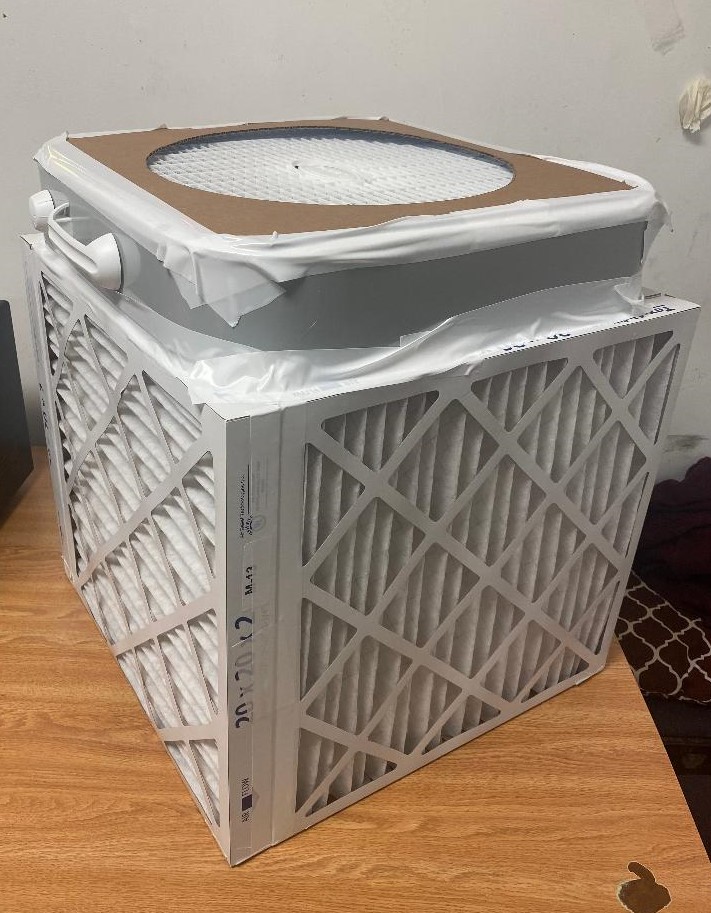
| Particle Size | Ambient | CR box – New M13 Filters | Efficiency |
|---|---|---|---|
| 0.3 um | 136600 | 68400 | 50% |
| 0.5 um | 16900 | 5500 | 67% |
| 1 um | 5400 | 1500 | 72% |
| 2.5 um | 2500 | 0 | 100% |
| 5 um | 1000 | 0 | 100% |
| 10 um | 600 | 0 | 100% |
| Speed | Velocity | Decibels |
|---|---|---|
| 1 | 540 | 50 Dba |
| 2 | 665 | 55 Dba |
| 3 | 780 | 60 Dba |
Corsi-Rosenthal Box – 2 Months
This CR box was built with 4 – MERV 13 20X20X2 filters. Lasko fan. It has been used in the employee breakroom. It runs continuously 24/7. Service life – 2 months.
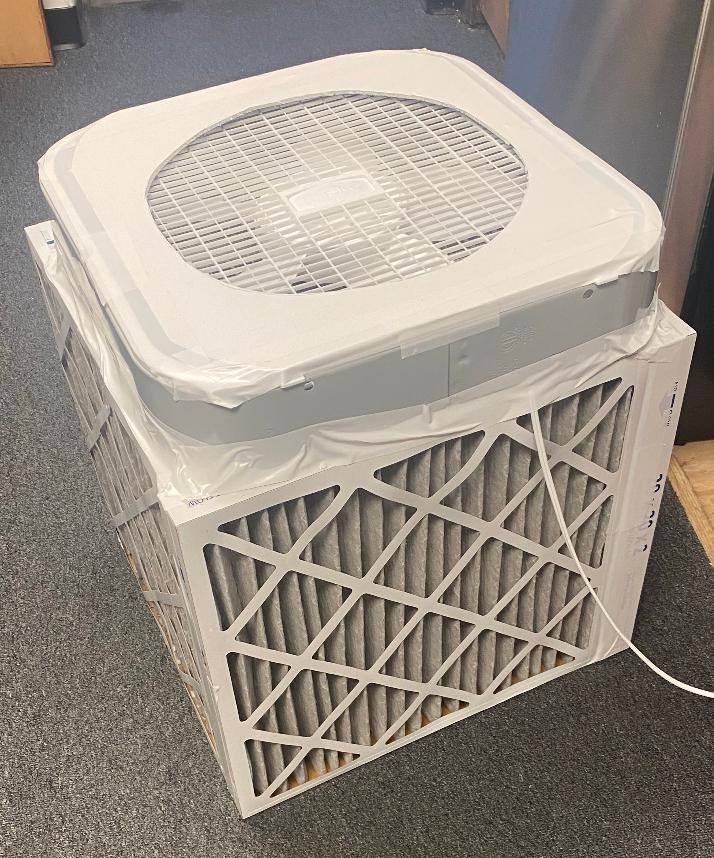
| Particle Size | Ambient | CR Box – M13 Filters 2 mos. | Efficiency |
|---|---|---|---|
| 0.3 um | 393000 | 225300 | 43% |
| 0.5 um | 56600 | 24000 | 58% |
| 1 um | 13400 | 3800 | 72% |
| 2.5 um | 5100 | 300 | 93.10% |
| 5 um | 1500 | 0 | 100.00% |
| 10 um | 900 | 0 | 100.00% |
| Speed | Velocity | Decibels |
|---|---|---|
| 1 | 521 FPM | 52 Dba |
| 2 | 640 FPM | 60 Dba |
| 3 | 760 FPM | 65 Dba |
Corsi-Rosenthal Box – 4 months
This CR box is built with 4 – MERV 13 – 20X20X2 Filters. It has been used continuously 24/7 for a period of 4 months. It is in a file room with 2 employees and the company laser printer.
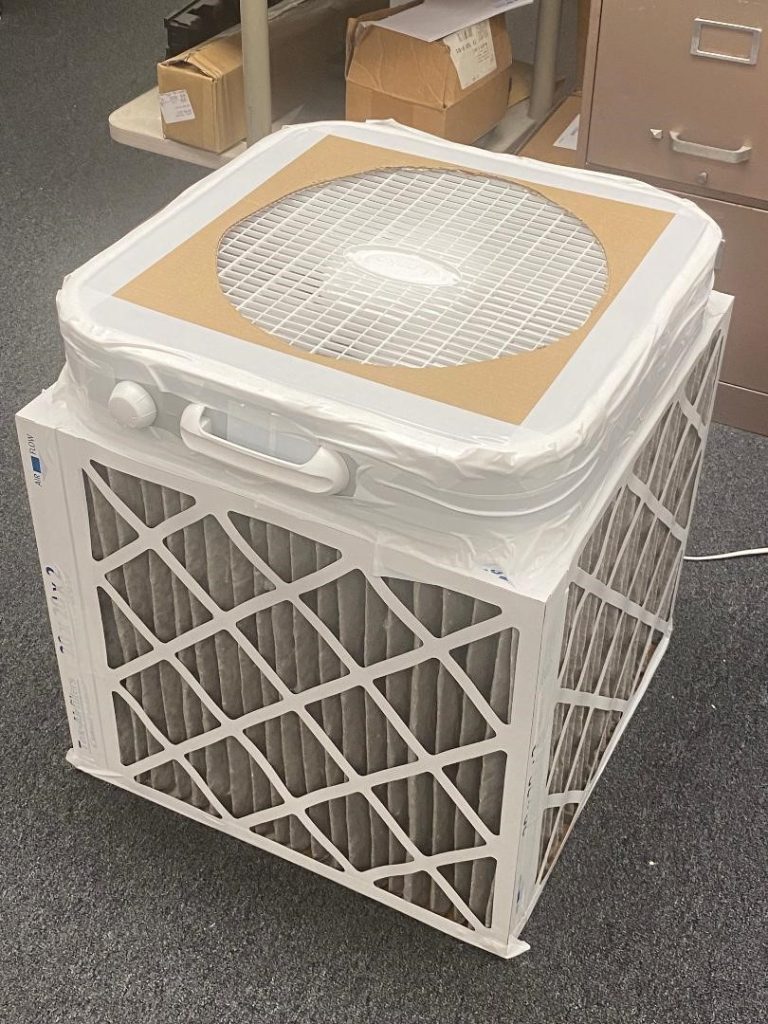
| Particle Size | Ambient | CR Box – 4 months | Efficiency |
| 0.3 um | 541000 | 280000 | 48% |
| 0.5 um | 54700 | 28000 | 49% |
| 1 um | 10500 | 4800 | 54% |
| 2.5 um | 2400 | 300 | 88% |
| 5 um | 500 | 0 | 100% |
| 10 um | 100 | 0 | 100% |
| Fan Speed | Velocity in FPM | Noise in Decibels |
| 1 | 510 | 50 |
| 2 | 650 | 54 |
| 3 | 770 | 59 |
Corsi-Rosenthal Box – 6 months
This CR box is built with 2 – 20X25X2, 2 – 16X25X2 and 1 – 20X20X2 MERV 13 filters. Lasko fan. In operation 6 months running continuously 24/7 in an office with two people.
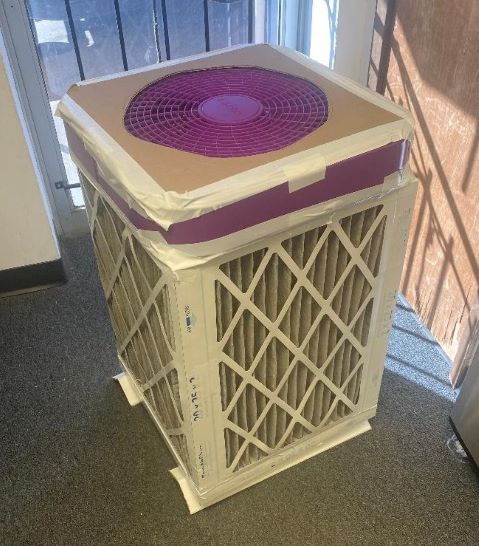
| Particle Size | Ambient | CR HIgh Boy – 6 months | Efficiency |
| 0.3 um | 428600 | 239800 | 44% |
| 0.5 um | 64000 | 31200 | 51% |
| 1 um | 12400 | 3200 | 74% |
| 2.5 um | 3900 | 600 | 85% |
| 5 um | 1400 | 0 | 100% |
| 10 um | 800 | 0 | 100% |
| Fan Speed | Velocity | Noise in Decibels |
| 1 | 530 FPM | 51 Dba |
| 2 | 730 FPM | 57 Dba |
| 3 | 890 FPM | 64 Dba |
Corsi-Rosenthal Box – 10 Months
This CR box is the first ever made. All of the filters were changed in April of 2021. It has run continuously in my office since then. It consists of 5 MERV 13 filters – 3 – 20X20X2 and 2 – 16X20X2. It uses a Utilitech fan.
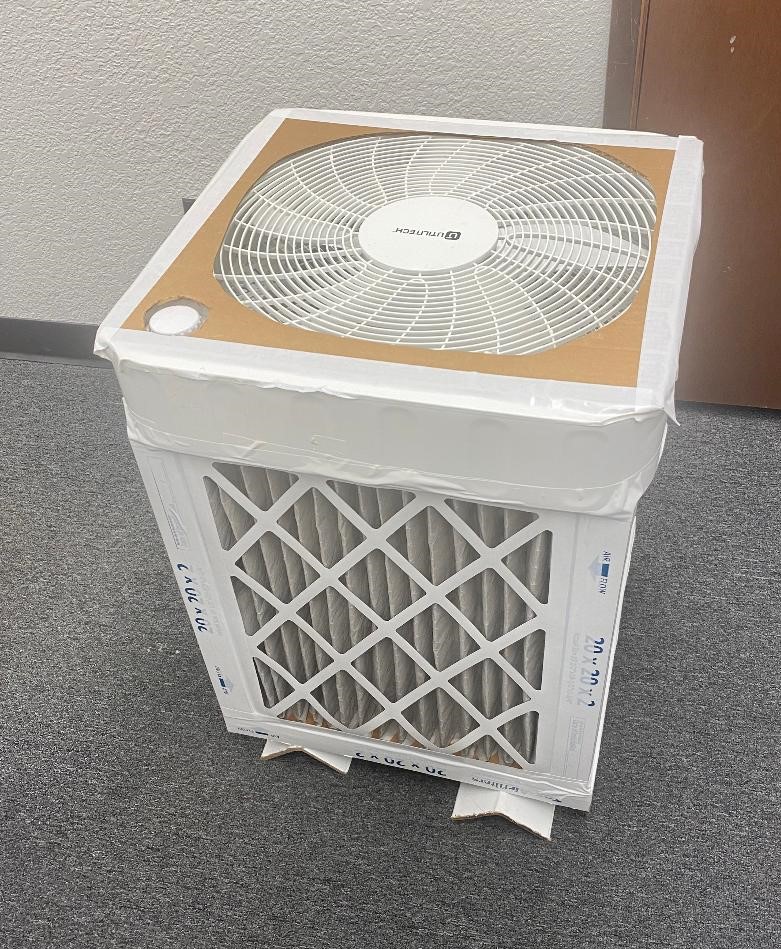
| Particle Size | Ambient | CR Box – 10 months | Efficiency |
| 0.3 um | 1007600 | 646000 | 36% |
| 0.5 um | 92200 | 53800 | 42% |
| 1 um | 17900 | 7200 | 60% |
| 2.5 um | 4600 | 1200 | 74% |
| 5 um | 1000 | 100 | 90% |
| 10 um | 700 | 100 | 86% |
| Fan Speed | Velocity | Noise in Decibels |
| 1 | 610 | 54 |
| 2 | 715 | 60 |
| 3 | 800 | 64 |
Here is a composite of all efficiency percentages of the five CR boxes using MERV 13 filters.

While the efficiency of the filters has decreased, it has remained at acceptable levels. In fact, if we use these percentages to compare with actual MERV numbers (E1= 0.3 to 1 um, E2 = 1- 3 um and E3 = 3-10 um) the new, 2-month-old, 4-month-old, and 6-month-old CR boxes would still qualify as MERV 13. The 10-month-old would be a MERV 12.
Also, MERV numbers represent single pass efficiency – not air cleaner effectiveness. As we have explained, effectiveness is determined by a combination of Filter + Fit + Flow. The velocity or “flow’ numbers have stayed at a high level as the filters have aged. Based on these numbers, it is reasonable to expect that all of these devices will continue to remove particles effectively.